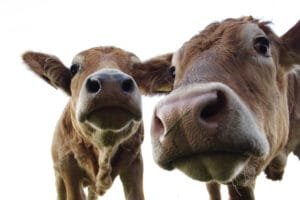Calculating CO2 Equivalent (CO₂e) for Math-phobics

It’s “Calculating CO₂ Equivalent (CO₂e) for Math-phobics”. Why? Because I’m math-phobic. And if you are, too, welcome.
Looking for a mentor who wouldn’t judge me for not understanding climate math, I turned to AI. It took four explanations to get me there.
That’s why we’re going to talk about apples. If you’re not math-phobic, jump to the Recap.
Calculating CO₂ Equivalent (CO₂e) for Math-phobics
What Does CO₂e Mean?
CO₂e stands for carbon dioxide equivalent. It’s how scientists group all greenhouse gases into one simple number based on how much they each contribute to global warming.
In other words:
CO₂e lets us compare apples to apples — even when dealing with cows, planes, or fertilizer.
It tells you how much a certain activity or product contributes to global warming, making it easier to compare things — a steak dinner, a flight, or a loaf of bread — using the same yardstick.
How Does It Work?
Every greenhouse gas — methane, nitrous oxide, etc. — gets converted into the amount of carbon dioxide (CO₂) that would have the same warming effect.
Think of:
- CO₂ = 1 apple
- Methane = 28 apples
- Nitrous oxide = 298 apples
Now you can stack all those apples and total them up.
CO₂e Is Expressed in Weight
Usually in kilograms (kg) or tonnes (metric tons).
So if something has 60 kg CO₂e, that means it warms the atmosphere as much as 60 kg of carbon dioxide would.
Let’s Keep Maligning the Cow
Let’s track one steak — roughly 1 kg of beef.
You’ve probably heard that cows burp methane (from digestion), and that methane is much stronger than carbon dioxide.
Yep. Over 100 years, methane has about 28 times the warming power of CO₂. So 1 kg of methane = 28 kg CO₂e = 28 apples.
But here’s the twist:
Why 1 kg of Beef = 60 kg CO₂e?
Wait — shouldn’t it be just 28 kg from the methane?
Nope. Because when we say “60 kg CO₂e,” we’re talking about all the greenhouse gases from the whole life cycle of that beef, not just the burps.
Here’s the breakdown:
- Methane from digestion (enteric fermentation):
~15–20 kg CO₂e
(Yes, mostly from burps. Methane = 28x CO₂.) - Methane & nitrous oxide from manure:
~10–15 kg CO₂e
(Methane when it’s stored, nitrous oxide when it’s spread on fields.) - Nitrous oxide from fertilizer (used to grow animal feed):
~10–12 kg CO₂e
(N₂O is ~298 times stronger than CO₂.) - CO₂ from producing & transporting feed:
~5–8 kg CO₂e
(Diesel fuel, machinery, processing grain or soy.) - Land-use change (like deforestation for pasture or crops):
~5–10 kg CO₂e
(Lost trees = lost carbon sinks + emissions from clearing.)
Add all them “apples” together, and we land at:
1 kg of beef = ~60 kg CO₂e
That means one kilo of beef warms the atmosphere as much as releasing 60 kg of carbon dioxide.
What About “Over 100 Years”?
Ah, yes. That little worm in our apple.
You might have noticed I said methane is “28 times stronger over 100 years.” That’s because greenhouse gases don’t all stick around the same length of time — some hit fast and fade (like methane), while others linger (like CO₂).
We’ll talk more about that in another article — there’s a link below to where we tackle Global Warming Potential (GWP), the science behind those numbers.
Recap
- CO₂e lets us compare the warming impact of all greenhouse gases in one simple number.
- CO₂ = 1 apple
- Methane = 28 apples
- Nitrous oxide = 298 apples
- 1 kg of beef = 60 kg CO₂e
→ That includes burps, poop, fertilizer, diesel, and deforestation.
→ That’s 60 apples’ worth of warming for every steak.
Scientists use Global Warming Potential (GWP) to understand how different gases compare. Here’s a link to GWP.
Related: Eating Sustainably: Foods with High Carbon Footprints.
Sources:
- Poore & Nemecek (2018), Science article on food’s environmental impacts
- Our World in Data – Environmental impact of food
